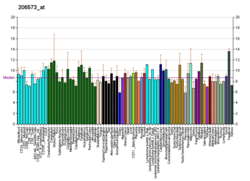KCNQ3
KvLQT3
Protein-coding gene in the species Homo sapiens
Kv7.3 (KvLQT3) is a potassium channel protein coded for by the gene KCNQ3.[5]
| KCNQ3 | |||||||||||||||||||||||||||||||||||||||||||||||||||
|---|---|---|---|---|---|---|---|---|---|---|---|---|---|---|---|---|---|---|---|---|---|---|---|---|---|---|---|---|---|---|---|---|---|---|---|---|---|---|---|---|---|---|---|---|---|---|---|---|---|---|---|
| Identifiers | |||||||||||||||||||||||||||||||||||||||||||||||||||
| Aliases | KCNQ3, BFNC2, EBN2, KV7.3, potassium voltage-gated channel subfamily Q member 3 | ||||||||||||||||||||||||||||||||||||||||||||||||||
| External IDs | OMIM: 602232; MGI: 1336181; HomoloGene: 20949; GeneCards: KCNQ3; OMA:KCNQ3 - orthologs | ||||||||||||||||||||||||||||||||||||||||||||||||||
| |||||||||||||||||||||||||||||||||||||||||||||||||||
| |||||||||||||||||||||||||||||||||||||||||||||||||||
| |||||||||||||||||||||||||||||||||||||||||||||||||||
| |||||||||||||||||||||||||||||||||||||||||||||||||||
| |||||||||||||||||||||||||||||||||||||||||||||||||||
| Wikidata | |||||||||||||||||||||||||||||||||||||||||||||||||||
| |||||||||||||||||||||||||||||||||||||||||||||||||||
It is associated with benign familial neonatal epilepsy.
The M channel is a slowly activating and deactivating potassium channel that plays a critical role in the regulation of neuronal excitability. The M channel is formed by the association of the protein encoded by this gene and one of two related proteins encoded by the KCNQ2 and KCNQ5 genes, both integral membrane proteins. M channel currents are inhibited by M1 muscarinic acetylcholine receptors and activated by retigabine, a novel anti-convulsant drug. Defects in this gene are a cause of benign familial neonatal convulsions type 2 (BFNC2), also known as epilepsy, benign neonatal type 2 (EBN2).[5]
- "Human PubMed Reference:". National Center for Biotechnology Information, U.S. National Library of Medicine.
- "Mouse PubMed Reference:". National Center for Biotechnology Information, U.S. National Library of Medicine.
- Yus-Nájera, E; Muñoz A; Salvador N; Jensen B S; Rasmussen H B; Defelipe J; Villarroel A (2003). "Localization of KCNQ5 in the normal and epileptic human temporal neocortex and hippocampal formation". Neuroscience. 120 (2): 353–64. doi:10.1016/S0306-4522(03)00321-X. ISSN 0306-4522. PMID 12890507. S2CID 38381189.
- Gutman GA, Chandy KG, Grissmer S, et al. (2006). "International Union of Pharmacology. LIII. Nomenclature and molecular relationships of voltage-gated potassium channels". Pharmacol. Rev. 57 (4): 473–508. doi:10.1124/pr.57.4.10. PMID 16382104. S2CID 219195192.
- Ryan SG, Wiznitzer M, Hollman C, et al. (1991). "Benign familial neonatal convulsions: evidence for clinical and genetic heterogeneity". Ann. Neurol. 29 (5): 469–73. doi:10.1002/ana.410290504. PMID 1859177. S2CID 25424485.
- Lewis TB, Leach RJ, Ward K, et al. (1993). "Genetic heterogeneity in benign familial neonatal convulsions: identification of a new locus on chromosome 8q". Am. J. Hum. Genet. 53 (3): 670–5. PMC 1682419. PMID 8102508.
- Charlier C, Singh NA, Ryan SG, et al. (1998). "A pore mutation in a novel KQT-like potassium channel gene in an idiopathic epilepsy family". Nat. Genet. 18 (1): 53–5. doi:10.1038/ng0198-53. PMID 9425900. S2CID 10437379.
- Yang WP, Levesque PC, Little WA, et al. (1998). "Functional expression of two KvLQT1-related potassium channels responsible for an inherited idiopathic epilepsy". J. Biol. Chem. 273 (31): 19419–23. doi:10.1074/jbc.273.31.19419. PMID 9677360.
- Wang HS, Pan Z, Shi W, et al. (1998). "KCNQ2 and KCNQ3 potassium channel subunits: molecular correlates of the M-channel". Science. 282 (5395): 1890–3. Bibcode:1998Sci...282.1890W. doi:10.1126/science.282.5395.1890. PMID 9836639.
- Schroeder BC, Kubisch C, Stein V, Jentsch TJ (1999). "Moderate loss of function of cyclic-AMP-modulated KCNQ2/KCNQ3 K+ channels causes epilepsy". Nature. 396 (6712): 687–90. Bibcode:1998Natur.396..687S. doi:10.1038/25367. PMID 9872318. S2CID 4417442.
- Kubisch C, Schroeder BC, Friedrich T, et al. (1999). "KCNQ4, a novel potassium channel expressed in sensory outer hair cells, is mutated in dominant deafness". Cell. 96 (3): 437–46. doi:10.1016/S0092-8674(00)80556-5. PMID 10025409.
- Selyanko AA, Hadley JK, Wood IC, et al. (1999). "Two types of K(+) channel subunit, Erg1 and KCNQ2/3, contribute to the M-like current in a mammalian neuronal cell" (PDF). J. Neurosci. 19 (18): 7742–56. doi:10.1523/JNEUROSCI.19-18-07742.1999. PMC 6782456. PMID 10479678.
- Shapiro MS, Roche JP, Kaftan EJ, et al. (2000). "Reconstitution of muscarinic modulation of the KCNQ2/KCNQ3 K(+) channels that underlie the neuronal M current". J. Neurosci. 20 (5): 1710–21. doi:10.1523/JNEUROSCI.20-05-01710.2000. PMC 6772928. PMID 10684873.
- Rundfeldt C, Netzer R (2000). "The novel anticonvulsant retigabine activates M-currents in Chinese hamster ovary-cells tranfected with human KCNQ2/3 subunits". Neurosci. Lett. 282 (1–2): 73–6. doi:10.1016/S0304-3940(00)00866-1. PMID 10713399. S2CID 28431577.
- Selyanko AA, Hadley JK, Wood IC, et al. (2000). "Inhibition of KCNQ1-4 potassium channels expressed in mammalian cells via M1 muscarinic acetylcholine receptors". J. Physiol. 522 Pt 3 (3): 349–55. doi:10.1111/j.1469-7793.2000.t01-2-00349.x. PMC 2269765. PMID 10713961.
- Cooper EC, Aldape KD, Abosch A, et al. (2000). "Colocalization and coassembly of two human brain M-type potassium channel subunits that are mutated in epilepsy". Proc. Natl. Acad. Sci. U.S.A. 97 (9): 4914–9. Bibcode:2000PNAS...97.4914C. doi:10.1073/pnas.090092797. PMC 18332. PMID 10781098.
- Schwake M, Pusch M, Kharkovets T, Jentsch TJ (2000). "Surface expression and single channel properties of KCNQ2/KCNQ3, M-type K+ channels involved in epilepsy". J. Biol. Chem. 275 (18): 13343–8. doi:10.1074/jbc.275.18.13343. PMID 10788442.
- Hirose S, Zenri F, Akiyoshi H, et al. (2000). "A novel mutation of KCNQ3 (c.925T-->C) in a Japanese family with benign familial neonatal convulsions". Ann. Neurol. 47 (6): 822–6. doi:10.1002/1531-8249(200006)47:6<822::AID-ANA19>3.0.CO;2-X. PMID 10852552. S2CID 11096248.
- Main MJ, Cryan JE, Dupere JR, et al. (2000). "Modulation of KCNQ2/3 potassium channels by the novel anticonvulsant retigabine". Mol. Pharmacol. 58 (2): 253–62. doi:10.1124/mol.58.2.253. PMID 10908292. S2CID 11112809.
- Wickenden AD, Yu W, Zou A, et al. (2000). "Retigabine, a novel anti-convulsant, enhances activation of KCNQ2/Q3 potassium channels". Mol. Pharmacol. 58 (3): 591–600. doi:10.1124/mol.58.3.591. PMID 10953053.
- Tinel N, Diochot S, Lauritzen I, et al. (2000). "M-type KCNQ2-KCNQ3 potassium channels are modulated by the KCNE2 subunit". FEBS Lett. 480 (2–3): 137–41. doi:10.1016/S0014-5793(00)01918-9. PMID 11034315. S2CID 8386123.
- Wickenden AD, Zou A, Wagoner PK, Jegla T (2001). "Characterization of KCNQ5/Q3 potassium channels expressed in mammalian cells". Br. J. Pharmacol. 132 (2): 381–4. doi:10.1038/sj.bjp.0703861. PMC 1572592. PMID 11159685.
- Yus-Najera E, Santana-Castro I, Villarroel A (2002). "The identification and characterization of a noncontinuous calmodulin-binding site in noninactivating voltage-dependent KCNQ potassium channels". J. Biol. Chem. 277 (32): 28545–53. doi:10.1074/jbc.M204130200. PMID 12032157.
- KCNQ3+Potassium+Channel at the U.S. National Library of Medicine Medical Subject Headings (MeSH)
This article incorporates text from the United States National Library of Medicine, which is in the public domain.
This membrane protein–related article is a stub. You can help Wikipedia by expanding it. |




